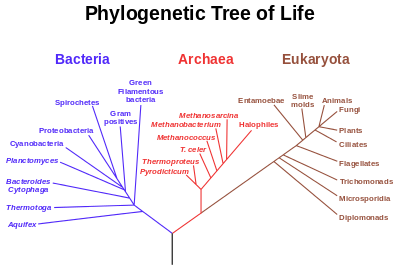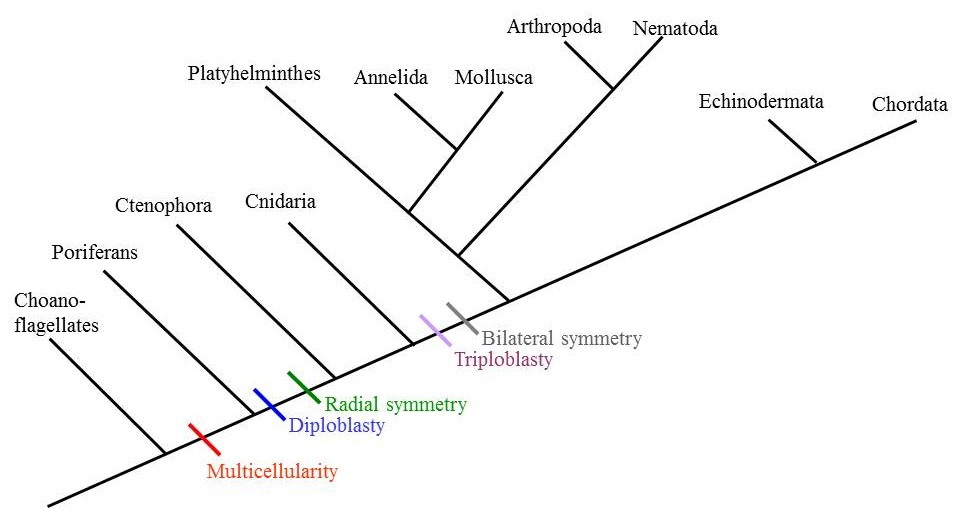The Five-striped Smooth-tail
Where do I fit in? (Classification)
Domain: Eukarya
Kingdom: Animalia
Phylum: Arthropoda
Class: Arachnida
Order: Scorpiones
Family: Buthidae
Genus: Leiurus
Species: Leiurus quinquestriatus
Domain: Eukarya The domain Eukarya evolved over 2 billion years ago from endosymbiosis with proteobacterium. The organisms in this domain are classified by having a true nucleus, mitochondria, and other membrane-bound organelles. This domain is the most discovered one of the three as you can tell by looking at this tree.
Kingdom: Animalia In order to be classified under the kingdom Animalia, organisms need to be multicellular, motile at some point in their development, heterotrophs, lack a cell wall, and must ingest and then digest their food.
Phylum: Arthropoda Organisms belonging to the phylum Arthropoda are described by having bilateral symmetry, jointed segments legs, and a chitinous exoskeleton which they end up molting in order to grow larger. The Deathstalker scorpion is classified under Arthropoda because it meets all these requirements.
Class: Arachnida To be classified as an Arachnid, the organism must have four pairs of legs and a body divided into two segments, abdomen and cephalothorax (Shehab et al. 2011). Something that sets these organisms apart from other insects is the absence of antennae and wings (Shehab et al. 2011). By looking at pictures of the Deathstalker, you can tell that it is segmented, contains no antennae or wings and has a body that is divided into two segments.
Order: Scorpiones Characteristics pertaining to the order Scorpiones include eight legs (four pairs), a pair of grasping claws, and a narrowed, segmented tail. The tail is carried forward over their body with a stinger at the tip that contains venom (Shehab et al. 2011).
Family: Buthidae Family Buthidae is one of the largest scorpion families that originated from North Africa. Organisms in this family can contain anywhere from two to five pairs of eyes. They are referred to as the thick-tailed scorpions and they have an almost triangular sternum (Goyffon et al. 2012).
Genus: Leiurus It was thought that the species, Leiurus quinquestriatus, was the only member of the genus Leiurus until 2002. However, it has now been discovered that there are four others within the genus (Goyffon et al. 2012). Generally members of the genus Leiurus are yellow in color with brown to blackish areas covering parts of their bodies.
Species: Leiurus quinquestriatus The scientific Latin name Leiurus quinquestriatus translates to “five-striped smooth- tail” in English.
Phylogenetic Trees
A phylogenetic tree is basically a “genetic road mad” that shows how organisms are linked by ancestry. They can be classified by their DNA genotype and their molecular data. The phylogenetic tree pictured above shows how kingdom Animalia is broken down into the many different phyla under the major clade Opisthokonta, and it also shows where our organism fits in. L. quinquestriatus belongs to phylum Arthropoda which is a sister group to the phylum Nematoda, as you can see from the tree above. Phylum Arthropda has evolved farther away from the rather simple body types of the phyla Platyhelminthes and Cnidaria and closer towards the more complex body types of Echinodermata and Chordata. The Platyhelminthes and Cnidarians have two tissue types, diploblasty, and radial symmetry. The phyla Arthropda, Echinodermata and Chordata have developed a more complex body type including three tissue types, triploblasty, and bilateral symmetry. Where all these traits evolved can be seen on the tree above.
↓↓↓↓↓↓
This phylogenetic tree shows how order Scorpiones is broken down into the many different families. As you can see from the red arrows, L. quinquestriatus belongs to family Buthidae. All these families can be further broken down into genus and species making the trees even more complex. Family Buthidae differs from all other families in that it is considered to be the group of thick tailed scorpions and it is one of the largest scorpion families.
Go back to our Home page or continue on to Habitat page


